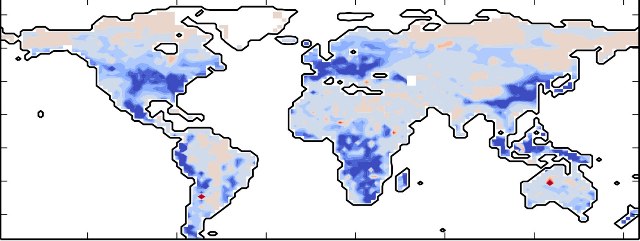Nov 11 2014
A new climate change modeling tool developed by scientists at Indiana University, Princeton University and the National Oceanographic and Atmospheric Administration finds that carbon dioxide removal from the atmosphere owing to greater plant growth from rising CO2 levels will be partially offset by changes in the activity of soil microbes that derive their energy from plant root growth.
 Projections for net carbon loss due to root-soil interactions, shown in blue, were strongest in temperate North America, Western Europe, Southeast Asia and Southern Africa. (Photo by Benjamin N. Sulman - Indiana University)
Projections for net carbon loss due to root-soil interactions, shown in blue, were strongest in temperate North America, Western Europe, Southeast Asia and Southern Africa. (Photo by Benjamin N. Sulman - Indiana University)
Soils hold more carbon than all of the earth’s plant biomass and atmosphere combined. The new work published by Benjamin N. Sulman, a postdoctoral researcher in the lab of co-author and IU Department of Biology associate professor Richard P. Phillips, identifies the highly active community of chemicals and organisms in the rhizosphere, or the soil that surrounds roots, as the driver behind increased emissions.
“The deposition of compounds such as sugars and organic acids from living roots can increase the activity of bacteria and fungi, and it’s this increase in activity that accelerates the decomposition of carbon in the soil, leading to higher CO2 emissions,” Sulman said. “On the other hand, this increased activity can transform carbon compounds into forms more easily locked onto soil particles, allowing them to stay in the soil for longer periods of time.”
Global simulations conducted by the team found that microbial responses to enhanced root activity under rising CO2, while depending on plant species, climate and soil mineralogy, led to a loss of global soil carbon stocks that counteracted the additional carbon storage resulting from increased plant growth in many regions of the world. The strongest of these effects were found in temperate North America, Western Europe, Southeast Asia and Southern Africa, while gains in soil carbon capture were greatest in boreal North America, Siberia and tropical South America.
Prior to the new research published today in Nature Climate Change, computer models used to simulate future climate change generally had not been able to simulate interactions between plant growth and microbial decomposition rates. The new modeling tool -- Carbon, Organisms, Rhizosphere and Protection in the Soil Environment, or CORPSE -- represents a major advance in the ability of scientists to simulate the global carbon cycle.
The model has already been integrated into the next generation of the global land model used for climate simulations by the NOAA Geophysical Fluid Dynamics Laboratory, a major national climate modeling center.
“This model will allow critical plant-soil interaction processes to be included in future climate assessments,” Phillips said. “To not consider how microbes influence soil carbon in offsetting ways, promoting losses through enhanced decomposition but gains by protecting soil carbon, would lead to overestimates or underestimates of the role soils play in influencing global climate.”
Simulations for the experiments were projected over a 30-year period and found that root-microbe interactions stimulated protection of carbon in soils where cold temperatures limited decomposition (high altitudes), and in regions like tropical South America where high soil clay content allowed carbon compounds to be locked onto mineral particles, protecting them from microbial decomposition. Rapid decomposition facilitated by warm temperatures and abundant moisture in these same tropical regions slowed the accumulation of organic matter that was not protected from microbial decomposers.
Model simulations can always be improved by testing predictions against field data collected from different ecosystems, and Sulman and Phillips are doing just that: investigating how roots influence soil decomposition and protected forms of carbon in forests that vary in the composition of tree and microbial communities.
“These experiments will enable us to further test and refine the underlying processes in the CORPSE model and should lead to improved predictions of the role of plant-soil interactions in global climate change,” Sulman said.
“Microbe-driven turnover offsets mineral-mediated storage of soil carbon under elevated CO2” appeared online today in Nature Climate Change. Co-authors with Sulman and Phillips were A. Christopher Oishi of the U.S. Forest Service and Elena Shevliakova and Stephen W. Pacala, both of Princeton University.
Funding for the research was provided by the U.S. Department of Commerce, the U.S. Department of Agriculture’s SFRI Program, BP and Princeton University. Global simulations were supported by the Geophysical Fluid Dynamics Laboratory using the Gaea supercomputer of the National Climate-Computing Research Center at Oak Ridge National Laboratory.